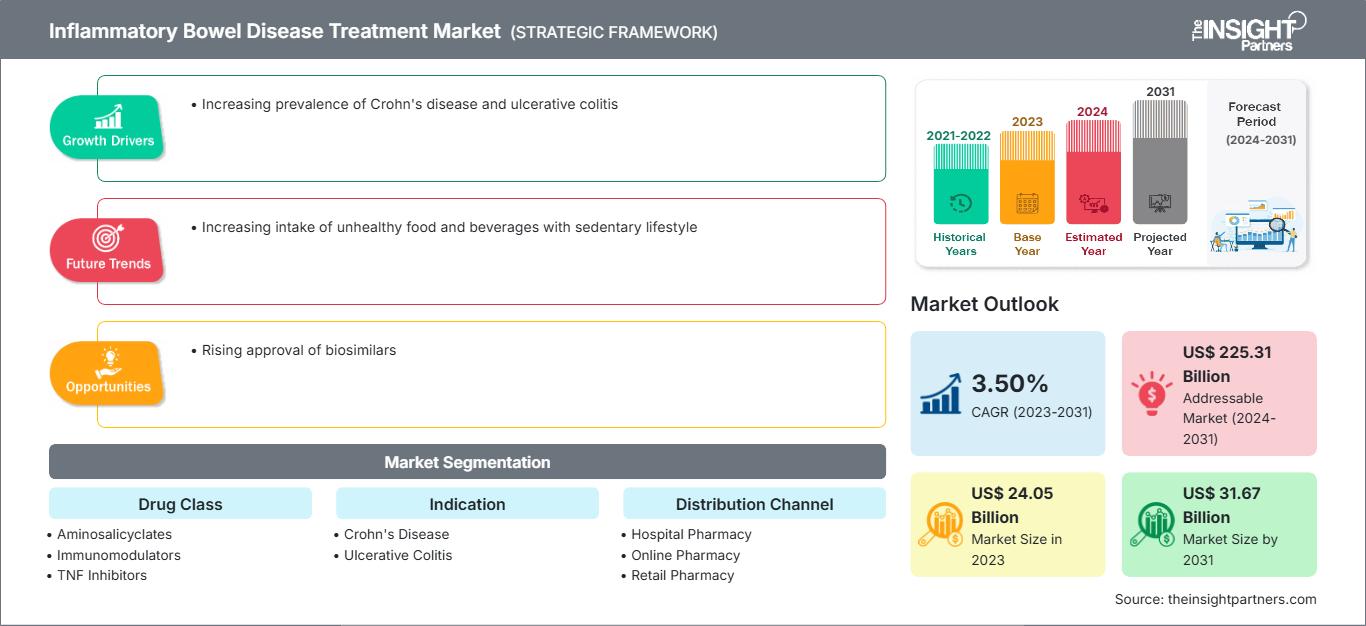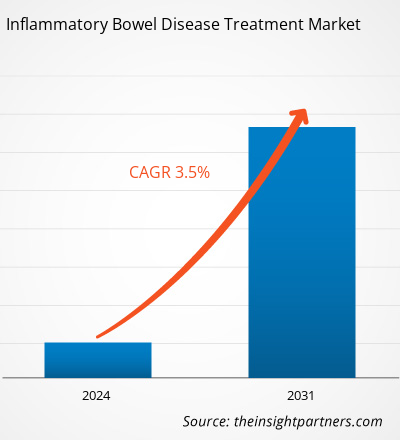Se prevé que el valor del mercado de tratamientos para la enfermedad inflamatoria intestinal crezca de 24.050 millones de dólares estadounidenses en 2023 a 31.670 millones de dólares estadounidenses en 2031; se anticipa que el mercado registre una tasa de crecimiento anual compuesta (TCAC) del 3,50% entre 2023 y 2031.
Perspectivas del mercado y opinión de los analistas:
La enfermedad inflamatoria intestinal (EII) es una afección inflamatoria crónica del tracto gastrointestinal, que incluye la enfermedad de Crohn y la colitis ulcerosa. Estas afecciones provocan inflamación del revestimiento del tracto digestivo, lo que conlleva síntomas como dolor abdominal, diarrea, fatiga y pérdida de peso. El tratamiento tiene como objetivo reducir la inflamación, controlar los síntomas y prevenir complicaciones mediante medicamentos, cambios en el estilo de vida y, en ocasiones, cirugía. El manejo de la EII generalmente requiere atención médica y seguimiento continuos para mantener la remisión y mejorar la calidad de vida. Los factores clave que impulsan el crecimiento del mercado de tratamientos para la enfermedad inflamatoria intestinal son la creciente prevalencia de la enfermedad de Crohn y la colitis ulcerosa, y el aumento en el número de lanzamientos de productos. Este informe incluye las perspectivas de crecimiento derivadas de las tendencias actuales del mercado de tratamientos para la enfermedad inflamatoria intestinal y su impacto previsible durante el período de pronóstico. Es probable que los avances tecnológicos generen tendencias significativas en el mercado de tratamientos para la enfermedad inflamatoria intestinal en los próximos años. Además, se espera que el desarrollo de tratamientos innovadores a través de la investigación continua, así como las iniciativas gubernamentales que los fomentan, también impulsen el crecimiento del mercado.
Factores de crecimiento y desafíos:
La enfermedad de Crohn es un trastorno crónico y complejo que afecta principalmente al sistema digestivo. La Biblioteca Nacional de Medicina informó que en 2023 se registraron 825 casos de enfermedad inflamatoria intestinal (EII) por cada 100 000 habitantes, de los cuales 410 correspondían a la enfermedad de Crohn y 414 a colitis ulcerosa y EII no clasificada. Con una prevalencia del 0,82 %, 322 600 canadienses padecían EII en 2023. Los pacientes con enfermedades gastrointestinales presentan un mayor riesgo de deterioro nutricional debido a los ayunos necesarios para las pruebas diagnósticas, las restricciones dietéticas terapéuticas y la pérdida de apetito causada por la anorexia o las alteraciones en las necesidades nutricionales derivadas de la propia enfermedad. Por ello, se prescribe nutrición enteral a estos pacientes, ya que esta vía es la preferida para proporcionar los nutrientes necesarios. En consecuencia, la creciente prevalencia de la enfermedad de Crohn y la colitis ulcerosa impulsa el crecimiento del mercado de tratamientos para la enfermedad inflamatoria intestinal.
La enfermedad de Crohn, las enfermedades gastrointestinales secundarias a traumatismos, la obstrucción intestinal, la colitis microscópica, el síndrome del intestino corto y la colitis ulcerosa son algunas de las enfermedades gastrointestinales más comunes. Según un artículo publicado en Healthline en 2021, aproximadamente el 40 % de la población mundial padece trastornos gastrointestinales funcionales. La Fundación Canadiense de Salud Digestiva afirma que millones de canadienses viven con enfermedades digestivas; aproximadamente 20 millones de canadienses, es decir, dos de cada tres personas, sufren trastornos digestivos cada año.
Por otro lado, el elevado coste del tratamiento de la enfermedad inflamatoria intestinal (EII) supone una importante barrera en el mercado de tratamientos para la EII. Desde medicamentos costosos hasta hospitalizaciones y cirugías frecuentes, el manejo de la EII puede representar una pesada carga financiera para los pacientes y los sistemas de salud. El coste suele limitar el acceso a una atención óptima y a tratamientos innovadores para muchas personas que viven con EII. Abordar los problemas de asequibilidad y accesibilidad es fundamental para mejorar los resultados y la calidad de vida de los pacientes afectados por esta enfermedad crónica. Por lo tanto, el elevado coste del tratamiento dificulta el crecimiento del mercado de tratamientos para la enfermedad inflamatoria intestinal.
Obtendrá personalización en cualquier informe, sin cargo, incluidas partes de este informe o análisis a nivel de país, paquete de datos de Excel, así como también grandes ofertas y descuentos para empresas emergentes y universidades.
Mercado de tratamientos para la enfermedad inflamatoria intestinal: Perspectivas estratégicas

- Obtenga las principales tendencias clave del mercado que se describen en este informe.Esta muestra GRATUITA incluirá análisis de datos, desde tendencias del mercado hasta estimaciones y pronósticos.
Segmentación y alcance del informe:
El análisis del mercado de tratamientos para la enfermedad inflamatoria intestinal se ha realizado considerando los siguientes segmentos: clase de fármaco, indicación de la enfermedad y canal de distribución. Geográficamente, el mercado de tratamientos para la enfermedad inflamatoria intestinal se segmenta en Norteamérica (EE. UU., Canadá y México), Europa (Reino Unido, Alemania, Francia, Italia, España y resto de Europa), Asia Pacífico (China, Japón, India, Australia, Corea del Sur y resto de Asia Pacífico), Oriente Medio y África (Emiratos Árabes Unidos, Arabia Saudita, Sudáfrica y resto de Oriente Medio y África) y Sudamérica y Centroamérica (Brasil, Argentina y resto de Sudamérica y Centroamérica).
Análisis segmentario:
Información basada en clases de fármacos
Según su clase farmacológica, el mercado se segmenta en biológicos, aminosalicilatos, corticosteroides y otros. El segmento de biológicos ostentó la mayor cuota de mercado en el tratamiento de la enfermedad inflamatoria intestinal en 2023, y se prevé que registre la mayor tasa de crecimiento anual compuesto (TCAC) durante el período 2023-2031.
Perspectivas basadas en la indicación de la enfermedad
Según la indicación de la enfermedad, el mercado de tratamientos para la enfermedad inflamatoria intestinal se divide en enfermedad de Crohn y colitis ulcerosa. Se prevé que el segmento de la enfermedad de Crohn mantenga una cuota de mercado significativa para 2031.
Perspectivas basadas en la indicación de la enfermedad
Según el canal de distribución, el mercado se clasifica en farmacias hospitalarias, farmacias minoristas y farmacias en línea. Se prevé que el segmento de farmacias hospitalarias mantenga una cuota de mercado significativa en el tratamiento de la enfermedad inflamatoria intestinal para 2031.
Perspectivas regionales del mercado de tratamientos para la enfermedad inflamatoria intestinal
Los analistas de The Insight Partners han explicado en detalle las tendencias y los factores regionales que influyen en el mercado de tratamientos para la enfermedad inflamatoria intestinal durante el período de previsión. Esta sección también analiza los segmentos y la geografía del mercado de tratamientos para la enfermedad inflamatoria intestinal en Norteamérica, Europa, Asia Pacífico, Oriente Medio y África, y Sudamérica y Centroamérica.
Alcance del informe de mercado sobre el tratamiento de la enfermedad inflamatoria intestinal
| Atributo del informe | Detalles |
|---|---|
| Tamaño del mercado en 2023 | US$ 24.050 millones |
| Tamaño del mercado para 2031 | 31.670 millones de dólares estadounidenses |
| Tasa de crecimiento anual compuesto global (2023 - 2031) | 3,50% |
| Datos históricos | 2021-2022 |
| Período de pronóstico | 2024-2031 |
| Segmentos cubiertos | Por clase de fármaco
|
| Regiones y países cubiertos | América del norte
|
| Líderes del mercado y perfiles de empresas clave |
|
Densidad de los actores del mercado de tratamientos para la enfermedad inflamatoria intestinal: comprensión de su impacto en la dinámica empresarial
El mercado de tratamientos para la enfermedad inflamatoria intestinal está creciendo rápidamente, impulsado por la creciente demanda de los usuarios finales debido a factores como la evolución de las preferencias de los consumidores, los avances tecnológicos y una mayor conciencia de los beneficios del producto. A medida que aumenta la demanda, las empresas amplían su oferta, innovan para satisfacer las necesidades de los consumidores y aprovechan las nuevas tendencias, lo que impulsa aún más el crecimiento del mercado.

- Obtenga una visión general de los principales actores del mercado de tratamientos para la enfermedad inflamatoria intestinal.
Análisis regional:
El alcance geográfico del informe sobre el mercado de tratamientos para la enfermedad inflamatoria intestinal abarca Norteamérica, Europa, Asia Pacífico, Oriente Medio y África, y Sudamérica y Centroamérica. En 2023, Norteamérica ostentó la mayor cuota de mercado. Estados Unidos domina el mercado norteamericano con la mayor participación en los ingresos. El crecimiento del mercado de tratamientos para la enfermedad inflamatoria intestinal en este país se atribuye al aumento de la prevalencia de enfermedades inflamatorias, la presencia de los principales actores del mercado y sus iniciativas estratégicas. Las mejores soluciones de pago, las altas tasas de tratamiento, el incremento en la prescripción de medicamentos innovadores, la continuidad de la investigación y las iniciativas gubernamentales favorables también benefician al mercado de tratamientos para la enfermedad inflamatoria intestinal en Estados Unidos y otros países norteamericanos. La Crohn's & Colitis Foundation es una de las organizaciones más destacadas dedicadas a promover la investigación clínica y traslacional dirigida a la cura de la colitis y la enfermedad de Crohn.
Panorama competitivo y empresas clave:
El pronóstico del mercado de tratamientos para la enfermedad inflamatoria intestinal presentado en este informe puede ayudar a las partes interesadas a planificar sus estrategias de crecimiento. AbbVie Inc., Takeda Pharmaceutical Company Limited, Pfizer Inc., Biogen, Novartis AG, Lilly, UCB SA, CELLTRION INC., Merck & Co., Inc. y Johnson & Johnson Services, Inc. son algunas de las empresas clave analizadas en el informe. Estas empresas se centran en ampliar su oferta para satisfacer la creciente demanda mundial. Su presencia global les permite atender a numerosos clientes, lo que a su vez les permite expandir su presencia en el mercado.
- Análisis histórico (2 años), año base, pronóstico (7 años) con CAGR
- Análisis PEST y FODA
- Tamaño del mercado, valor/volumen: global, regional y nacional
- Industria y panorama competitivo
- Conjunto de datos de Excel
Informes recientes
Testimonios
Razón para comprar
- Toma de decisiones informada
- Comprensión de la dinámica del mercado
- Análisis competitivo
- Información sobre clientes
- Pronósticos del mercado
- Mitigación de riesgos
- Planificación estratégica
- Justificación de la inversión
- Identificación de mercados emergentes
- Mejora de las estrategias de marketing
- Impulso de la eficiencia operativa
- Alineación con las tendencias regulatorias






















 Obtenga una muestra gratuita para - Mercado de tratamiento de la enfermedad inflamatoria intestinal
Obtenga una muestra gratuita para - Mercado de tratamiento de la enfermedad inflamatoria intestinal